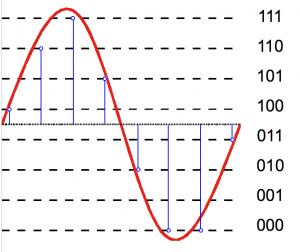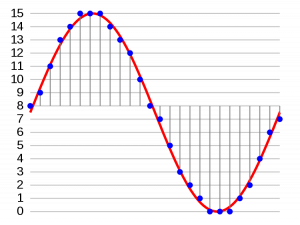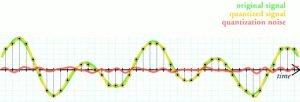The subject of Discussion: Pulse Code Modulation (PCM)
- What is Pulse Code Modulation?
- Important features of PCM
- Sampling Method in Pulse Code Modulation (PCM)
- Encoding in Pulse Code Modulation (PCM)
- What is Quantization?
- Advantages of PCM
- Disadvantages of PCM
- Important applications of Pulse Code Modulation (PCM)
What is Pulse Code Modulation?
Definition of PCM:
“Pulse code modulation or PCM is a distinct type of A-to-D conversion method in which the data or info enclosed in the samples of an analog signal is obtainable by a digital procedures.”
In this method, each of the digital signals has n number of binary digits, there are M= 2n unique number of code is possible, and all these codes have a specific amplitude level. However, for each sample significance from the analog signal could be any one of an unlimited levels.
The digitally encrypted word characterized by the amplitude closest to the actual sampled value is used. This is named as quantizing and process entitled as quantization. As an alternative of using the similar sample value of the analog form w(kTs), the nearby allowable value substitutes the sample, where there are M allowed values, each corresponding to one of the code words. Other widespread categories of A-to-D conversions, i.e, Delta-modulation (DM) and the differential pulse code modulation (DPCM), are discussed later.

Image Credit: Hyacinth, 3-bit resolution analog comparison, CC BY-SA 3.0
Important features of Pulse Code Modulation:
Pulse coded modulation has various features. Some of the important features of Pulse Code Modulation are the following:
- PCM technique is comparatively cheap digital circuitry and could have used extensively for various applications.
- Pulse Code Modulation signal is resulting from all categories of analog signal (vedio, audiovisual, etc.) combination with data signal (i.e., available from the digital computers or laptop) and communicated over a standard fast-speed digital telecommunication scheme. This multiplexing technique is called TDM and is talk over in a separate section.
- In a distanced digital telecommunication schemes requiring a repeaters, a clean PCM signal restored at the each repeater’s o/p, where the i/p be made up of PCM pulse mixed with noise. Nevertheless, the noise in the i/p signal might create o/p bit-errors in the PCM technique.
- The signal-noise ratio of a digital system could have improved in comparison to the analog system. The error probability in the system output could be minimized even further by using proper coding based encryption technique. This compensate the main disadvantage of PCM; a much broader bandwidth range than the analogous analog techniques is requirement.
Sampling, Quantizing and Encoding in PCM:
The Pulse Code Modulation signal is generated from the quantized Pulse Amplitude Modulated signal. Quantized values are encoded here.
Generally, a system designer is designated to state the same code word or encryption represented by a specific quantized level for a Gray code. In this resulting Pulse Code Modulation signal, this word or byte for every quantized sample is strobed out the encoder by the next immediate pulse. The Gray code is utilized because, in this, only a one-bit will alter for each step of quantization. Typically, the ‘errors’ in the received PCM signal will cause minimal errors in the received analog signal, provided that the sign bit is not in error.
PCM methods exemplify the quantized analog sample value by the binary codes. As a general rule, it is probable to define the quantized analog samples by digital words using a base other than ‘2’ or, evenly, to transform the binary to other multi-level signal.

Operations in the Transmitter:
Sampling
The message signals pass under a process of sampling where they are sampled by the pulse signals. To reform the signal back to its original form, there is a specific condition for sampling rate. The rate must be the multiple of 2 or more of the greatest frequency component present in the signal.
Nyquist’s theorem is one of the important rule in the process of sampling. It deals with the sampling rate and necessary conditions for reconstruction of a signal after being sampled. The theorem is important not only for the Pulse Coded Modulations, but also for each and every modulation techniques and for every aspects of signal theories and signal applications. Mathematically, it says:
Fs >= 2 * Fmax
Here, Fs is the frequency of sampling and Fmax is the value of the greatest frequency component present in the signal.
Antialiasing filters plays a major role here. They omits specific frequency bands which are generally higher than the W.

Image credit : Dr.J.L Mazher Iqbal Slideplayer Presentation
Encoding
Encoding refers to the process of conversion by which datas are symbolised through some specific symbols, or characters. This process brings more security to the communication system. That is why the process is important. For long transmission there is always possibility of unwanted interferences. Encoding saves us from those attacks.
In Pulse Coded modulation technique of transmission, the analog datas are converted to the digital signal. This part of operation is one of the important stage. It can be also stated as the ‘Stage of Digitization’.
The constant communication signal gets converted to distinct values. This distinct procedures in a code is called a code element or symbol. A code element or symbol is given by the discrete events in a code. As we know, the binary codes are given by Zeros and Ones.
Quantization
“The Quantizing is a procedure of minimizing the extra unnecessary bits and limiting the data.”

State the advantages and disadvantages of PCM:
Advantages of PCM
- It transmits signals uniformly.
- PCM has an efficient SNR.
- PCM always offers efficient regeneration.
Disadvantages of PCM
- Attenuation occurs due to noise and cross-talks.
- PCM needs a larger bandwidth for transmission.
- Other errors are also observed during transmission.
For more electronics related article click here

Hi, I am Soumali Bhattacharya. I have done Master’s in Electronics.
I am currently invested in the field of Electronics and communication.
My articles are focused on the major areas of core electronics in a very simple yet informative approach.
I am a vivid learner and try to keep myself updated with all the latest technologies in the field of Electronics domains.
Let’s connect through LinkedIn –